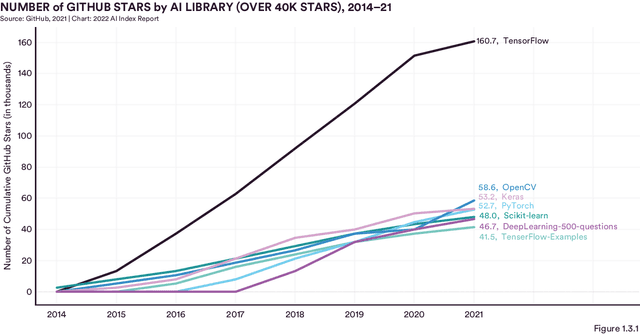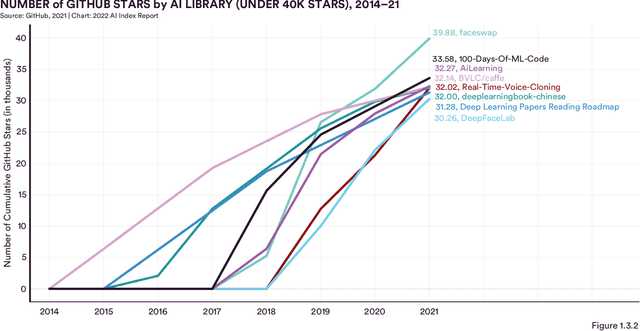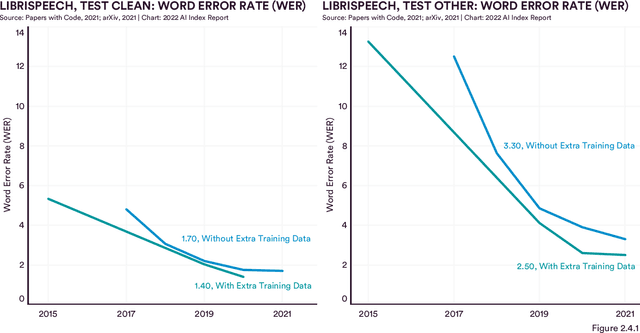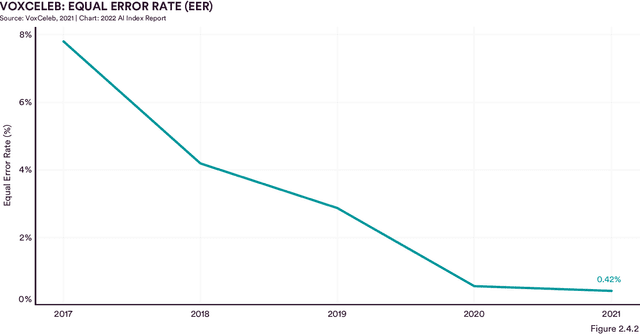Nestor Maslej
Artificial Intelligence Index Report 2025
Apr 08, 2025Abstract:Welcome to the eighth edition of the AI Index report. The 2025 Index is our most comprehensive to date and arrives at an important moment, as AI's influence across society, the economy, and global governance continues to intensify. New in this year's report are in-depth analyses of the evolving landscape of AI hardware, novel estimates of inference costs, and new analyses of AI publication and patenting trends. We also introduce fresh data on corporate adoption of responsible AI practices, along with expanded coverage of AI's growing role in science and medicine. Since its founding in 2017 as an offshoot of the One Hundred Year Study of Artificial Intelligence, the AI Index has been committed to equipping policymakers, journalists, executives, researchers, and the public with accurate, rigorously validated, and globally sourced data. Our mission has always been to help these stakeholders make better-informed decisions about the development and deployment of AI. In a world where AI is discussed everywhere - from boardrooms to kitchen tables - this mission has never been more essential. The AI Index continues to lead in tracking and interpreting the most critical trends shaping the field - from the shifting geopolitical landscape and the rapid evolution of underlying technologies, to AI's expanding role in business, policymaking, and public life. Longitudinal tracking remains at the heart of our mission. In a domain advancing at breakneck speed, the Index provides essential context - helping us understand where AI stands today, how it got here, and where it may be headed next. Recognized globally as one of the most authoritative resources on artificial intelligence, the AI Index has been cited in major media outlets such as The New York Times, Bloomberg, and The Guardian; referenced in hundreds of academic papers; and used by policymakers and government agencies around the world.
The Foundation Model Transparency Index v1.1: May 2024
Jul 17, 2024Abstract:Foundation models are increasingly consequential yet extremely opaque. To characterize the status quo, the Foundation Model Transparency Index was launched in October 2023 to measure the transparency of leading foundation model developers. The October 2023 Index (v1.0) assessed 10 major foundation model developers (e.g. OpenAI, Google) on 100 transparency indicators (e.g. does the developer disclose the wages it pays for data labor?). At the time, developers publicly disclosed very limited information with the average score being 37 out of 100. To understand how the status quo has changed, we conduct a follow-up study (v1.1) after 6 months: we score 14 developers against the same 100 indicators. While in v1.0 we searched for publicly available information, in v1.1 developers submit reports on the 100 transparency indicators, potentially including information that was not previously public. We find that developers now score 58 out of 100 on average, a 21 point improvement over v1.0. Much of this increase is driven by developers disclosing information during the v1.1 process: on average, developers disclosed information related to 16.6 indicators that was not previously public. We observe regions of sustained (i.e. across v1.0 and v1.1) and systemic (i.e. across most or all developers) opacity such as on copyright status, data access, data labor, and downstream impact. We publish transparency reports for each developer that consolidate information disclosures: these reports are based on the information disclosed to us via developers. Our findings demonstrate that transparency can be improved in this nascent ecosystem, the Foundation Model Transparency Index likely contributes to these improvements, and policymakers should consider interventions in areas where transparency has not improved.
Bias in Text Embedding Models
Jun 17, 2024Abstract:Text embedding is becoming an increasingly popular AI methodology, especially among businesses, yet the potential of text embedding models to be biased is not well understood. This paper examines the degree to which a selection of popular text embedding models are biased, particularly along gendered dimensions. More specifically, this paper studies the degree to which these models associate a list of given professions with gendered terms. The analysis reveals that text embedding models are prone to gendered biases but in varying ways. Although there are certain inter-model commonalities, for instance, greater association of professions like nurse, homemaker, and socialite with female identifiers, and greater association of professions like CEO, manager, and boss with male identifiers, not all models make the same gendered associations for each occupation. Furthermore, the magnitude and directionality of bias can also vary on a model-by-model basis and depend on the particular words models are prompted with. This paper demonstrates that gender bias afflicts text embedding models and suggests that businesses using this technology need to be mindful of the specific dimensions of this problem.
Artificial Intelligence Index Report 2024
May 29, 2024Abstract:The 2024 Index is our most comprehensive to date and arrives at an important moment when AI's influence on society has never been more pronounced. This year, we have broadened our scope to more extensively cover essential trends such as technical advancements in AI, public perceptions of the technology, and the geopolitical dynamics surrounding its development. Featuring more original data than ever before, this edition introduces new estimates on AI training costs, detailed analyses of the responsible AI landscape, and an entirely new chapter dedicated to AI's impact on science and medicine. The AI Index report tracks, collates, distills, and visualizes data related to artificial intelligence (AI). Our mission is to provide unbiased, rigorously vetted, broadly sourced data in order for policymakers, researchers, executives, journalists, and the general public to develop a more thorough and nuanced understanding of the complex field of AI. The AI Index is recognized globally as one of the most credible and authoritative sources for data and insights on artificial intelligence. Previous editions have been cited in major newspapers, including the The New York Times, Bloomberg, and The Guardian, have amassed hundreds of academic citations, and been referenced by high-level policymakers in the United States, the United Kingdom, and the European Union, among other places. This year's edition surpasses all previous ones in size, scale, and scope, reflecting the growing significance that AI is coming to hold in all of our lives.
Foundation Model Transparency Reports
Feb 26, 2024Abstract:Foundation models are critical digital technologies with sweeping societal impact that necessitates transparency. To codify how foundation model developers should provide transparency about the development and deployment of their models, we propose Foundation Model Transparency Reports, drawing upon the transparency reporting practices in social media. While external documentation of societal harms prompted social media transparency reports, our objective is to institutionalize transparency reporting for foundation models while the industry is still nascent. To design our reports, we identify 6 design principles given the successes and shortcomings of social media transparency reporting. To further schematize our reports, we draw upon the 100 transparency indicators from the Foundation Model Transparency Index. Given these indicators, we measure the extent to which they overlap with the transparency requirements included in six prominent government policies (e.g., the EU AI Act, the US Executive Order on Safe, Secure, and Trustworthy AI). Well-designed transparency reports could reduce compliance costs, in part due to overlapping regulatory requirements across different jurisdictions. We encourage foundation model developers to regularly publish transparency reports, building upon recommendations from the G7 and the White House.
The Foundation Model Transparency Index
Oct 19, 2023Abstract:Foundation models have rapidly permeated society, catalyzing a wave of generative AI applications spanning enterprise and consumer-facing contexts. While the societal impact of foundation models is growing, transparency is on the decline, mirroring the opacity that has plagued past digital technologies (e.g. social media). Reversing this trend is essential: transparency is a vital precondition for public accountability, scientific innovation, and effective governance. To assess the transparency of the foundation model ecosystem and help improve transparency over time, we introduce the Foundation Model Transparency Index. The Foundation Model Transparency Index specifies 100 fine-grained indicators that comprehensively codify transparency for foundation models, spanning the upstream resources used to build a foundation model (e.g data, labor, compute), details about the model itself (e.g. size, capabilities, risks), and the downstream use (e.g. distribution channels, usage policies, affected geographies). We score 10 major foundation model developers (e.g. OpenAI, Google, Meta) against the 100 indicators to assess their transparency. To facilitate and standardize assessment, we score developers in relation to their practices for their flagship foundation model (e.g. GPT-4 for OpenAI, PaLM 2 for Google, Llama 2 for Meta). We present 10 top-level findings about the foundation model ecosystem: for example, no developer currently discloses significant information about the downstream impact of its flagship model, such as the number of users, affected market sectors, or how users can seek redress for harm. Overall, the Foundation Model Transparency Index establishes the level of transparency today to drive progress on foundation model governance via industry standards and regulatory intervention.
Artificial Intelligence Index Report 2023
Oct 05, 2023Abstract:Welcome to the sixth edition of the AI Index Report. This year, the report introduces more original data than any previous edition, including a new chapter on AI public opinion, a more thorough technical performance chapter, original analysis about large language and multimodal models, detailed trends in global AI legislation records, a study of the environmental impact of AI systems, and more. The AI Index Report tracks, collates, distills, and visualizes data related to artificial intelligence. Our mission is to provide unbiased, rigorously vetted, broadly sourced data in order for policymakers, researchers, executives, journalists, and the general public to develop a more thorough and nuanced understanding of the complex field of AI. The report aims to be the world's most credible and authoritative source for data and insights about AI.
The AI Index 2022 Annual Report
May 02, 2022



Abstract:Welcome to the fifth edition of the AI Index Report! The latest edition includes data from a broad set of academic, private, and nonprofit organizations as well as more self-collected data and original analysis than any previous editions, including an expanded technical performance chapter, a new survey of robotics researchers around the world, data on global AI legislation records in 25 countries, and a new chapter with an in-depth analysis of technical AI ethics metrics. The AI Index Report tracks, collates, distills, and visualizes data related to artificial intelligence. Its mission is to provide unbiased, rigorously vetted, and globally sourced data for policymakers, researchers, executives, journalists, and the general public to develop a more thorough and nuanced understanding of the complex field of AI. The report aims to be the world's most credible and authoritative source for data and insights about AI.
 Add to Chrome
Add to Chrome Add to Firefox
Add to Firefox Add to Edge
Add to Edge